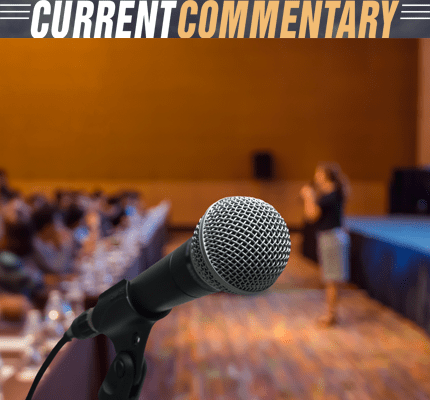
Young People Provide Teachable Messages of Powerful Speaking Up and Speaking Well
By Nichola D. Gutgold, Ph.D.
When I meet new people and tell them I teach public speaking, I get one of two very distinct reactions. People either loved the public speaking class they had in college, or they wished they had never taken the course at all. Those who loved the course usually consider themselves to be good public speakers. Those who thought it was a waste of their college time and money, usually those who would rather die than give a speech, consider themselves poor public speakers and believe that nothing they could do will change that.
By the end of each semester, I hope my students realize their potential. Good public speakers are not born, they are made. And the “secret sauce” of excellent, memorable public speaking is passion. When you absolutely believe in your message, you enter what I call the “flow state” of public speaking. Nothing is more powerful than examples of remarkable public speakers who seem to be in a flow state as they speak, and thus bring attention to their causes by forcefully speaking their truth.
Good public speakers are not born, they are made. And the “secret sauce” of excellent, memorable public speaking is passion.
To teach students about exemplar speakers in the past 25 years, I’ve shown United States presidents, company CEOs, prime ministers, and even celebrities. Former President Ronald Reagan consoling the nation after the Challenger Space disaster offered compassionate, patriarchal assurance that the ill-fated astronauts had “slipped the surly bonds of Earth to touch the face of God.” Steve Jobs offered on-point commencement advice at Stanford, reminding students, “Your time is limited, so don't waste it living someone else's life. Don't be trapped by dogma—which is living with the results of other people's thinking.” While both of these speakers and their speeches will go down in history as having made important contributions—not only to government and business, but to the field of public speaking and communication—they are not as likely to resonate with today’s college students as much as the new crop of young activists with whom students can relate and in whom they can truly see themselves.
Indeed, the present-day public speaking exemplars are not coming from Washington or from board rooms, or from other distinguished halls of leadership—no. Today, young people have given us the best examples of public speaking at its finest, and it is a hopeful sign that the world is in good hands.
There are many reasons why students find these young speakers more credible than more famous elders. Perhaps the best reason can be found in Kenneth Burke’s theory of identification. Burke uses the theory to reclaim elements of rhetoric that have fallen away, while also expanding on it to show how identification supplements traditional emphases on persuasion. He argues that the theory gives us insight into what binds us together as people, and what we see as part of ourselves. Students are able to see themselves in the lives of the brave young rhetors. Aristotle believed that the most important quality in a speaker is character, and these speakers resonate with students because they fulfill the requirements of character: they are trustworthy, they are similar to their audience in age and appearance, and, despite their youth (or perhaps because of it), they are authoritative and expert in their arguments. Students can envision taking similar stances on topics of passion and interest to themselves. When students see these young speakers, they are more convinced than ever that public speaking skills can be useful. As Lloyd Bitzer argued, a rhetorical situation may not be anticipated. Thus, speaking well is a desirable life skill to cultivate, perhaps not for use in the moment, but one never knows when one will be impelled to speak out.
Greta Thunberg, now 17, TIME Magazine’s 2019 person of the year, is the latest example of a child who has used public speaking to call for immediate action from the adults who make laws that affect climate change. Her passionate, unapologetic cries for accountability got our attention, and no amount of bullying or put-downs will stop her. She’s right when she says that she is being ridiculed because she is having an impact. Go, Greta!
Malala Yousafzai, who was shot by the Taliban in 2012 at age 15 for speaking out in support of girls’ education in Pakistan, continued her advocacy, undaunted by the attack she suffered, and is the youngest-ever Nobel laureate. She is an international figure of humanity and determination.
Many student survivors of the 2018 Stoneman Douglas High School shooting criticized the familiar response from politicians, asking them not to offer condolences but instead to take action to prevent more students from being killed in school shootings. Emma Gonzalez eloquently and forcefully derided politicians from offering “thoughts and prayers,” and called for action to end gun violence. David Hogg, another Stoneman Douglass student, has had threats on his life for speaking out against gun violence. Despite the threats, he continues to speak out.
Then there are the victims of convicted and imprisoned gymnastics physician Larry Nassar, who sexually abused dozens of gymnasts for years. After one brave gymnast came forward, years after the abuse, dozens followed. It took just one woman to speak out to cause an avalanche of accusations. By speaking out as young women, these brave victims not only put away a dangerous person, they also prevented more abuse by him and potential abuse by others who saw the power of young people coming forward.
As a professor, I’m always looking for new ways to engage my students. To watch a student with seemingly zero interest in the class in the beginning of the semester become a believer, someone who can see themselves using the material in the future, feels like a teaching victory. I want students to see the relevance. For most students, picturing themselves using speech as a President or a Supreme Court justice does not resonate. That might seem disappointing, but it is not. When it comes to leadership through speech, young people are the best role models we have today, and that is the most inspiring lesson of all.
References:
Bitzer, L. (1968). The Rhetorical Situation. Philosophy & Rhetoric, 1(1), 1-14. Retrieved from www.jstor.org/stable/40236733.
Burke, Kenneth, 1897-1993. (1969). A grammar of motives. Berkeley: University of California Press.
Honeycutt, L. (2004). Aristotle's Rhetoric, Public Homepage Web Server. Retrieved December 18, 2019, from the website temoa: Open Educational Resources (OER) Portal.


